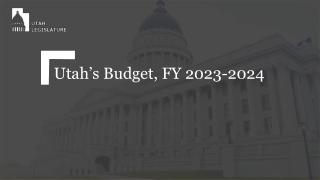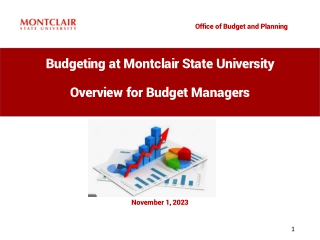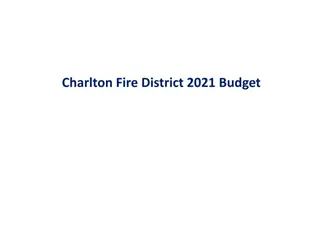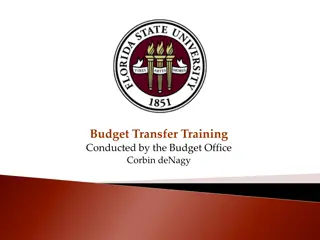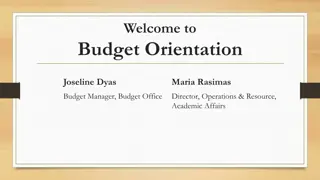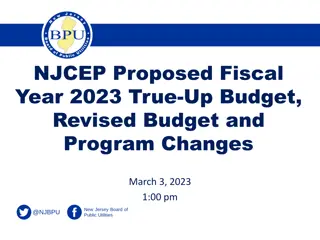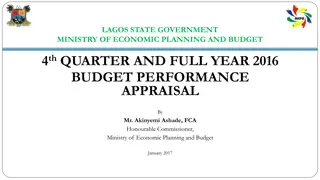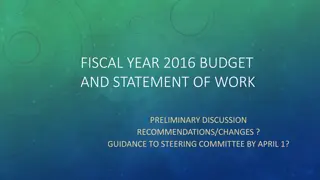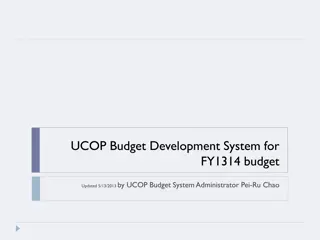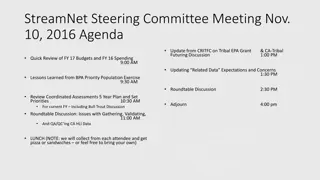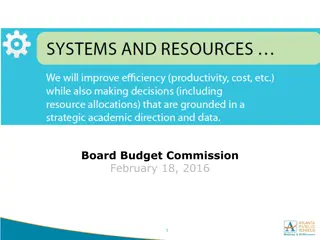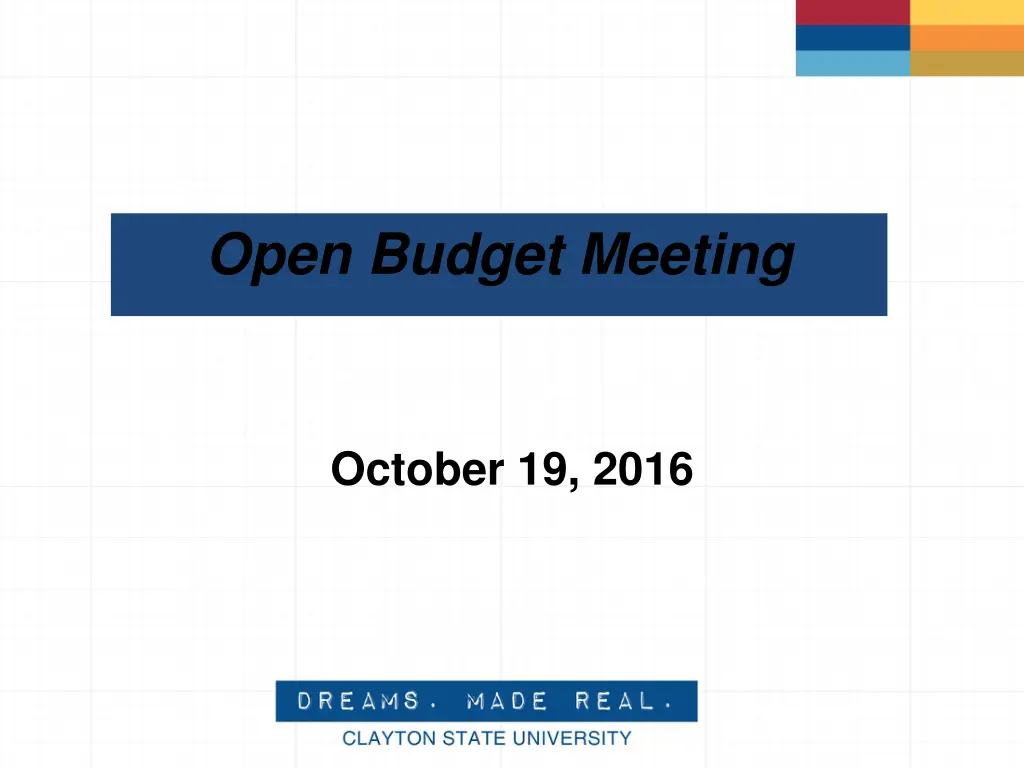
Clayton State University Budget Meeting Insights
Explore the successes, challenges, budget calendar, university resources, state appropriation and tuition trends, as well as tuition, fees, and enrollment projections discussed at the open budget meeting on October 19, 2016. Discover how Clayton State University is navigating financial realities while focusing on financial ratios and economic conditions affecting revenue collection.
Download Presentation

Please find below an Image/Link to download the presentation.
The content on the website is provided AS IS for your information and personal use only. It may not be sold, licensed, or shared on other websites without obtaining consent from the author. If you encounter any issues during the download, it is possible that the publisher has removed the file from their server.
You are allowed to download the files provided on this website for personal or commercial use, subject to the condition that they are used lawfully. All files are the property of their respective owners.
The content on the website is provided AS IS for your information and personal use only. It may not be sold, licensed, or shared on other websites without obtaining consent from the author.
E N D
Presentation Transcript
Open Budget Meeting October 19, 2016
Open Budget Meeting State of the University:Our Successes and Challenges Successes: AJC Top Workplace U.S. News & World Report ranking Merit Increases MOWR- Record Enrollments Ranked #11 2017 Safest College Campuses in Georgia (Niche https://colleges.niche.com/rankings/safest-colleges/s/georgia/ ) Tree Campus USA Challenges: Enrollment- Headcount Auxiliary Profitability Financial Trends & Ratios Aging Infrastructure 2
Budget Calendar & Timeline Governor s Proposal January CSU/BOR Request to OPB Aug- Sept General Assembly Winter CSU s Internal Budget Process BOR Allocation June/July Finalized & BOR Axn Spring 3
Clayton State Universitys Resources Tuition & Fees Auxiliary Enterprises StateAppropriations 2017 Major Repair & Renovations (MRR) Sponsored Programs CSU Foundation Endowments Scholarships Unrestricted Annual Giving State Approp. 40.5% Other 59.5% Uses Restrictions Realities Salaries and Wages Utilities Supplies/Equipment & Travel Technology Facilities and Maintenance Public Safety Campus Activities and Services Capital funds can not be used to pay for salaries and wages State procurement guidelines must be followed Student fees must be used in conjunction with specific services Prudent fiscal management required for all sources State Appropriation varies Focus on Financial Ratios Economic conditions have a direct impact on our ability to collect the revenues necessary to satisfy the needs and obligations of the University 4
Open Budget Meeting STATE APPROPRIATION & TUITION TRENDS FY12-FY16 Fiscal Year State Appropriation Tuition FY13 $22,799,099 $26,520,536 FY14 $23,251,922 $27,338,759 FY15 $24,067,121 $27,333,575 FY16 $25,198,595 $26,735,500 FY17 $24,687,212 $27,831,086* $29,000,000 $27,000,000 $25,000,000 $23,000,000 State Appropriation Tuition $21,000,000 $19,000,000 $17,000,000 *FY17 Tuition is projected $15,000,000 FY13 FY14 FY15 FY16 FY17 5
Open Budget Meeting Tuition, Fees, Enrollment Projections, and Impacts Tuition revenue projection based on a Fall 2016 headcount of 7,050 used. Actual enrollment headcount for Fall 2016 is 6,996. Spring 2017 Projected Headcount 6,850 Summer 2017 Projected Headcount 3,110 The Summer 2017 tuition revenue projection is based on a headcount of 2,900. We are cautiously optimistic that we will meet our Spring targets and we are not expecting a shortfall for Summer 2017. All Fee Holders Revenue down for Fall 2016. 6
Open Budget Meeting Enrollment Headcounts PROJECTIONS FY13 FY14 FY15 FY16 FY17* FY18 FY19 FY20 FY21 FY Total 17,538 17,180 16,540 9,632 17,010 17,265 17,540 17,835 18,175 Fall 7,140 7,261 7,022 7012 6996# 7,150 7,260 7,390 7,565 Spring 6,954 6,976 6,747 6,850 6,850 6,950 7,050 7,145 7,260 Summer 3,444 2,943 2,771 2,782 3,110 3,165 3,230 3,300 3,350 *FY17 includes Fall 2016, Spring 2017, and Summer 2017 # Based on preliminary institutional counts (7050) projected 8
Open Budget Meeting Mandatory Fees Fall 2016 Actuals vs. Budget Budget Description Collected Remaining Fees Fall Semester 269,087.00 (284,540.36) 15,453.36 Fee Waivers Fall Semester 0.00 27,613.57 (27,613.57) (12,160.21)Health Fee Fees Fall Semester 200,007.00 (210,312.44) 10,305.44 127,942.00 Fee Waivers Fall Semester Fees Fall Semester 0.00 20,410.03 (131,629.80) (20,410.03) 3,687.80 (10,104.59)Parking Fee Fee Waivers Fall Semester 0.00 16,840.60 (16,840.60) (13,152.80)Laker Card Fee Fees Fall Semester 940,083.00 (989,705.60) 49,622.60 Fee Waivers Fall Semester Fees Fall Semester 0.00 96,088.80 (371,139.60) (96,088.80) 19,011.60 (46,466.20)Athletic Fee 352,128.00 Fee Waivers Fall Semester Fees Fall Semester 0.00 35,957.70 (634,663.50) (35,957.70) 36,473.50 (16,946.10)Student Activity Fee 598,190.00 Fee Waivers Fall Semester Fees Fall Semester 0.00 62,553.00 (386,149.35) (62,553.00) 36,476.35 (26,079.50)SAC Fee 349,673.00 Fee Waivers Fall Semester 0.00 48,523.53 (48,523.53) (12,047.18)Technology Fee (136,956.58)TOTAL 9
Open Budget Meeting Revenue - 7,050 Fall Enrollment FY17 Budget 24,687,217 27,000,000 5,666,930 800,000 State Appropriation Tuition Fees & Other General Carry Forward Funds 58,154,147 Expenditures Updated current budget including cuts needed 56,883,402 Funding Available to Distribute 1,270,745 Required Funding Items added: University Contingency Increase in software licenses Faculty Promotions including benefits Funding for Merit Raises including benefits 99,000 11,311 48,175 1,112,259* 1,270,745 Additional Funds Needed 0 * 82% provided by BOR; 18% provided by CSU 10
Open Budget Meeting Capital Budget FY 2017 Major Repairs & Renovations(MRR) allocation of $691,535 can be used for these projects: o Meet requirements for Georgia Power to be on TMR o Replace Electrical Heating System at Spivey Hall o Replace all Air Handler Units, Controls, Electrical as Needed at Library, Phase II of III o Correct ADA Compliance Campus Wide Academic Core Renovations-Roofing $1.35M Looking Back Academic Core Design $1.4M & Academic Core Roofing $1.35M Looking Forward Academic Core Renovations Construction Phase 2 of 3 $6.9M Campus Renovations Arts and Sciences 1st floor HVAC replacement Replace Air Handler Advising Center Public Safety Clayton Station Phase I- Lower 400 Units Library Testing Center Dental Clinic CAS 11
Open Budget Meeting DEVELOPING ISSUES FINANCIAL HEALTH (FINANCIAL RATIOS & TRENDS WHAT ARE THEY AND WHAT DO THEY TELL?) They are a TOOL that assists the institution with achievement of its goals by: Measuring success factors against institutional strategic objectives Identifying financial anomalies and focusing attention on matters that should be of concern to the institution and Allows the institution to establish benchmarks for comparisons with similar institutions 12
Four Categories of Fiscal Health SACS 2013/14 13
Current Cash Viability Ability to pay short-term & long-term. Can we pay our debt with our cash/cash equivalents like short-term investments? CHECKING & SAVINGS /MONTHLY BILLS Availability of expendable net assets to cover debt as of balance sheet date. FUNDS TO PAY MORTGAGE/CAR NOTE/ALL OBLIGATIONS Pay current liabilities with cash and cash equivalents. CHECKING & SAVINGS ACCOUNT
Capital Liability Burden Ratio Primary Reserves Return on Net Assets Measure of whether or not the institution's resources are growing. This ratio determines whether the institution is financially better off than in previous years by measuring total economic return. A decline in this ratio may be appropriate and even warranted if it reflects a strategy to better fulfill the institution's mission. An improving trend in this ratio indicates that the institution is increasing its net assets and is likely to be able to set aside financial resources to strengthen its future financial flexibility. STOCK PORTFOLIO PAYING DIVIDENDS , HOME VALUE INCREASING Measures what percentage of an institution s income is used to make PPV payments. Basically, the percentage of total revenues in any given fiscal year that are used to pay an institution s capital lease payments associated with the PPV program. Measure of financial strength. How long could CSU use its expendable reserves to carry on business? Without relying on additional revenue. STOCKS, BONDS, SAVINGS APPLYING FOR A HOME LOAN AND THE DEBT TO INCOME RATIO
CSU Ratio Analysis CSU Ratios FY 2016 FY 2015 FY 2014 FY 2013 Current Ratio 1.81 1.96 2.31 2.07 Cash Ratio 1.60 1.73 1.93 1.85 Return on Net Assets .67 -.064 -.73 -.057 Net Operating Revenue .134 -.022 -.046 -.039 Primary Ratio Reserve -.207 -.233 .063 .075 Viability Ratio -.201 -.214 .076 .088 16
CSU Ratio Analysis FY 2016 FY 2015 CSU Ratios Primary Reserve Ratio Primary Reserve Ratio w/o Pension Aspire .15 to .25 Viability Ratio Viability Ratio w/o Pension Aspire .10 to .12 (.207) .063 (.233) .058 (.201) .08 (.214) .069 17
Open Budget Meeting HOW DID WE GET HERE? Enrollment Decrease Budget Reductions Tuition Freeze and Fee Freeze Revenue Reductions: Reduction in Fee Collections (MOWR-change in state law), Affordable Learning Grants, In-Kind Use of Facilities Reserve Use: Budget Transfers Film Studio Trammell Property Acquisition and Daycare Due Diligence UHS Buildout Loch s Nest Lakeside Caf Improvements Expenses Increased: Full Merit Increases even when only partially funded Summer Session Shortfalls Increase in Employee Levels Benefited Employees (ACA) Increase in Facilities-higher utilities 18
STEPS TO IMPROVE RATIOS Decrease Expenses Increase Revenues Improve Reserves or Increase Fund balances that do not lapse Auxiliary Services Reserves DSS- Departmental Sales and Services Tuition Carry Forward Indirect Costs
DIAGNOSTICS HIGH BLOOD PRESSURE Lack of Exercise Solution Increase Exercise Overweight Cut Calories FINANCIAL RATIOS Lack of Reserves Solution Increase Reserves Expenditures Budget Cut 20
Open Budget Meeting Unresolved Budgetary Issues Ratio Improvement One USG IT increase ADA Litigation Others? 21
Open Budget Meeting FY16 One Time Expenditures We funded almost $963K of additional requests from various departments across campus. 22
Open Budget Meeting FY 2018 BUDGET NARRATIVE 15 Questions: Top 3 or 4 Strategic priorities, enrollment, retention, progression, academic Programming, IT needs, Student Savings, Fiscal Health, Facilities needs, etc . Budget Narrative due October 21, 2016 submitted in preparation for BOR Budget Hearing in December. Prepare and plan for a budget cut ($533k). Right Sizing 23

